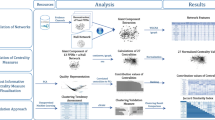Abstract
This paper presents a supervised Back Propagation Neural network (BPN) for the hub characterization of the tumor protein P53. This paper proposes a method to predict the P53 protein as Hub or Non-Hub from the sequence information of protein alone. The hubness characterization of this protein has been carried out using Hydrophobicity, one of the important physio-chemical properties of the amino acid. The proposed method has been tested on the P53 and its interacting proteins successfully. The same method on the whole set of Human proteins from the database HPRD and APID has shown around 90% of accuracy, sensitivity and specificity with the help of Artificial Neural Network (ANN).
Access this chapter
Tax calculation will be finalised at checkout
Purchases are for personal use only
Preview
Unable to display preview. Download preview PDF.
Similar content being viewed by others
References
Vazquez, A., Bond, E.E., Levine, A.J., Bond, G.L.: The genetics of the p53 pathway, apoptosis and cancer therapy. Nature Reviews Drug Discovery 7(12), 979–987 (2008)
Prives, C., Hall, P.A.: The p53 pathway. The Journal of Pathology. Special Issue: Molecular and Cellular Themes in Cancer Research 187(1), 112–126 (1999)
Hsing, M., Byler, K.G., Cherkasov, A.: The use of Gene Ontology terms for predicting highly-connected ’hub’ nodes in protein-protein interaction networks. BMC Systems Biology 2, 80 (2008)
Barabasi, A.L., Oltvai, Z.N.: Network biology: understanding the cell’s functional organization. Nat. Rev. Genet. 5(2), 101–113 (2004)
Srihari, S., et al.: Detecting Hubs and Quasi Cliques in Scale-free Networks. IEEE, Los Alamitos (2008)
Albert, R.: Scale-free networks in cell biology. J. Cell Sci. 118(Pt 21), 4947–4957 (2005)
Bataba, N.N., Hurst, L.D., Tyers, M.: Evolutionary and Physiological Importance of Hub Proteins. PLOS Computational Biology 2(7), 748–756 (2006)
Agarwal, S., et al.: Revisiting date and party hubs: Novel approaches to role assignment in protein interaction networks. PLOS Computational Biology 6(6) (June 2010)
Aragues, R., et al.: Characterization of Protein Hubs by Inferring Interacting Motifs from Protein Interactions. PLOS Computational Biology 3(9) (September 2007)
Vinod Chandra, S.S., Reshmi, G., Nair, A.S., S., S., Radhakrishna Pillai, M.: MTar: a computational microRNA target prediction architecture for human transcriptome. BMC Bioinformatics 11, S2, ISSN 1471-2105
Ying, X., Mural, R.J., Einstein, J.R., Shah, M.B., Uberbacher, E.: GRAIL: a multi-agent neural network system for gene identification. Proceedings of the IEEE 84(10) (1996)
Chae, M.H., Krull, F., Lorenzen, S., Knapp, E.: Predicting protein complex geometries with a neural network. Proteins 78(4), 1026–1039 (2010)
Agrawal, R.K., et al.: A novel approach to predict protein-protein interaction using protein sequence data. Bioinformatics Trends 1(1) (2006)
http://www.hprd.org/ (release 9 dated May 24, 2010)
Prieto, C., De Las Rivas, J.: APID: Agile Protein Interaction Data Analyzer. Nucl. Acids Res. 34, W228–W302 (2006)
http://en.wikipedia.org/wiki/P53 (dated 18/9/2011 at 9.00 a.m.)
http://www.ncbi.nlm.nih.gov/ (dated 18/9/2011 at 11.00 a.m.)
Wutchy, S.: Scale-free behavior in protein domain networks. Mol. Bio. Evolution 18 (2001)
Ashok, V.: Determination of blood glucose concentration by back propogation neural network
Latha, A., Vijayakumar Reddy, K.: Performance Analysis on modeling of loop heat pipes using artificial neural network. Indian Journal of Science and Technology 3(4) (2010)
http://www.sigmaaldrich.com/life-science/metabolomics/learning-centre/amino-acid-reference-chart.html (dated July 15, 2010)
Kim, P.M., Lu, L.J., Xia, Y.: Gerstein MB Relating three-dimensional structures to protein networks provides evolutionary insights. Science 314, 1938–1941 (2006)
Najafabadi, H.S., Salavati, R.: Sequence-based prediction of protein-protein interactions by means of codon usage. Genome Biology 9, R87 (2008)
Bock, J.R., Gough, D.A.: Predicting protein-protein interaction from primary structure. Bioinformatics 17, 455–460 (2001)
Shen, J., Zhang, J., Luo, X., Zhu, W., Yu, K., Chen, K., Li, Y., Jiang, H.: Predicting protein-protein interactions based only on sequence information. Proceedings of the National Academy of Sciences of the USA 104, 4337–4341 (2007)
Qi, Y., Bar-Joseph, Z., Klein-Seetharaman, J.: Evaluation of different biological data and computational classification methods for use in protein interaction prediction. Proteins 63(3), 490–500 (2006)
Editor information
Editors and Affiliations
Rights and permissions
Copyright information
© 2011 Springer-Verlag Berlin Heidelberg
About this paper
Cite this paper
Sajeev, J., Mahalakshmi, T. (2011). Hub Characterization of Tumor Protein P53 Using Artificial Neural Networks. In: Abraham, A., Lloret Mauri, J., Buford, J.F., Suzuki, J., Thampi, S.M. (eds) Advances in Computing and Communications. ACC 2011. Communications in Computer and Information Science, vol 190. Springer, Berlin, Heidelberg. https://doi.org/10.1007/978-3-642-22709-7_32
Download citation
DOI: https://doi.org/10.1007/978-3-642-22709-7_32
Publisher Name: Springer, Berlin, Heidelberg
Print ISBN: 978-3-642-22708-0
Online ISBN: 978-3-642-22709-7
eBook Packages: Computer ScienceComputer Science (R0)




